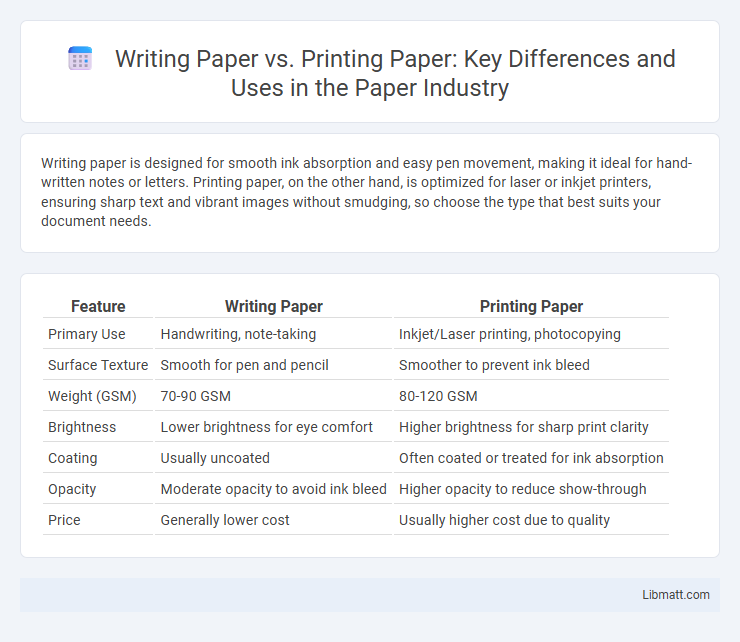Writing paper is designed for smooth ink absorption and easy pen movement, making it ideal for hand-written notes or letters. Printing paper, on the other hand, is optimized for laser or inkjet printers, ensuring sharp text and vibrant images without smudging, so choose the type that best suits your document needs.
Table of Comparison
| Feature | Writing Paper | Printing Paper |
|---|---|---|
| Primary Use | Handwriting, note-taking | Inkjet/Laser printing, photocopying |
| Surface Texture | Smooth for pen and pencil | Smoother to prevent ink bleed |
| Weight (GSM) | 70-90 GSM | 80-120 GSM |
| Brightness | Lower brightness for eye comfort | Higher brightness for sharp print clarity |
| Coating | Usually uncoated | Often coated or treated for ink absorption |
| Opacity | Moderate opacity to avoid ink bleed | Higher opacity to reduce show-through |
| Price | Generally lower cost | Usually higher cost due to quality |
Understanding Writing Paper
Writing paper is specially designed to provide a smooth, absorbent surface ideal for ink flow from pens, ensuring clear and legible handwriting. Unlike printing paper, which is optimized for inkjet or laser printers to produce crisp text and images, writing paper often features a heavier weight and a matte finish to prevent ink smudging. Your choice of writing paper greatly impacts the quality and appearance of handwritten documents, making it essential to select paper tailored to your writing instrument and purpose.
Defining Printing Paper
Printing paper is a specialized type of paper designed primarily for use in printers, copiers, and fax machines, characterized by its smooth texture and optimal brightness to ensure clear, sharp text and images. It typically has a weight ranging from 70 to 100 grams per square meter (gsm), balancing durability with ease of feeding through machines. Choosing the right printing paper enhances your printed documents' quality by reducing smudging and jamming, making it essential for professional and everyday print tasks.
Key Differences Between Writing and Printing Paper
Writing paper typically features a smoother texture and higher opacity to prevent ink from bleeding through, making it ideal for handwritten notes, while printing paper is designed with a balanced thickness and surface finish to suit various printer types and enhance print clarity. Printing paper often has a higher brightness level and is optimized for toner or ink adhesion, ensuring sharp text and vibrant images. Writing paper tends to have a weight ranging from 60 to 90 gsm, whereas printing paper is commonly found between 70 to 120 gsm, reflecting their different functional uses.
Composition and Material Quality
Writing paper typically consists of a smoother, finer fiber composition such as cotton or high-quality cellulose, which enhances ink absorption and prevents bleeding. Printing paper often contains a higher percentage of wood pulp combined with additives like clay or calcium carbonate to create a brighter, more opaque surface suited for inkjet or laser printing. The material quality in writing paper prioritizes durability and texture for handwriting, while printing paper emphasizes consistency and finish for sharp, clear printed images.
Surface Texture and Feel
Writing paper features a smoother surface texture designed to absorb ink evenly, providing a comfortable and precise writing experience without smudging. Printing paper typically has a slightly rougher finish to optimize toner or ink adhesion, ensuring sharp image and text reproduction during the printing process. Your choice between the two should consider whether tactile smoothness for handwriting or ink transfer quality for printing is more important.
Thickness and Weight Comparison
Writing paper typically ranges from 70 to 90 gsm (grams per square meter), offering a thinner and lighter option ideal for handwriting and everyday use. Printing paper generally has a higher weight, around 90 to 120 gsm, providing greater thickness and durability suitable for laser and inkjet printers. The increased density of printing paper enhances print quality and reduces ink bleed, while writing paper balances smoothness and flexibility for comfortable writing.
Best Uses for Writing Paper
Writing paper is specially designed for handwriting, calligraphy, and note-taking, providing a smooth surface that prevents ink bleeding and feathering, making it ideal for fountain pens and gel pens. It often features higher opacity and weight compared to printing paper, enhancing durability and readability for personal letters, journals, and professional correspondence. This paper is best suited for projects where clarity, ink absorption, and a refined texture are essential for a polished, legible result.
Ideal Applications for Printing Paper
Printing paper is ideal for high-volume printing tasks such as documents, flyers, and brochures where smooth, consistent texture ensures clear text and sharp images. Its weight and brightness are optimized to prevent ink bleed-through, enhancing readability and professional presentation. You can rely on printing paper for everyday office use and mass distribution materials that require durability and cost-efficiency.
Environmental Impact of Paper Types
Writing paper typically has a lower environmental impact compared to printing paper due to its use of fewer chemicals and less intensive bleaching processes. Printing paper often requires higher brightness and smoothness, leading to increased energy consumption and chemical treatments that contribute to water pollution and carbon emissions. Choosing recycled or sustainably sourced writing paper can significantly reduce deforestation and landfill waste associated with conventional printing paper production.
Choosing the Right Paper for Your Needs
Writing paper typically has a smoother texture and higher opacity, making it ideal for handwriting or calligraphy, while printing paper is designed for laser and inkjet printers, emphasizing brightness and ink absorption. Your choice depends on whether you prioritize crisp print quality or a comfortable writing experience. Selecting the right paper ensures optimal results, whether for your documents, correspondence, or creative projects.
Writing paper vs printing paper Infographic

 libmatt.com
libmatt.com